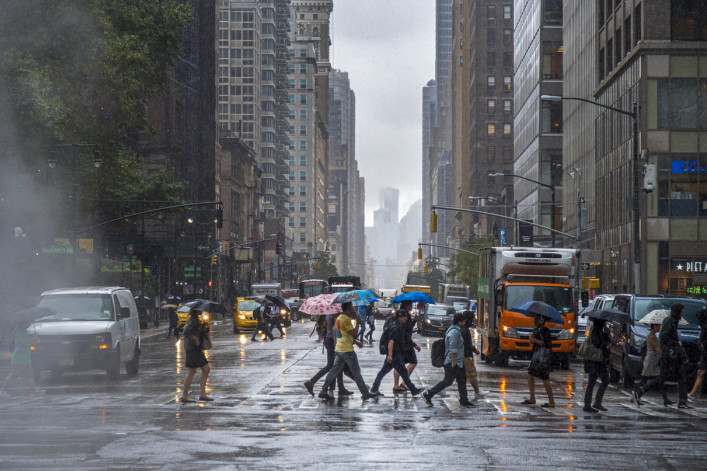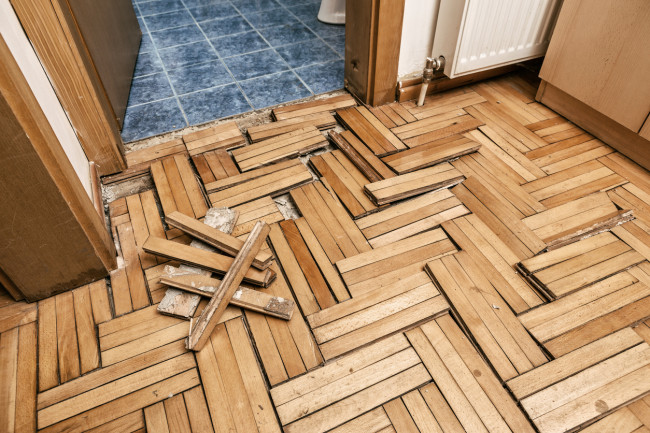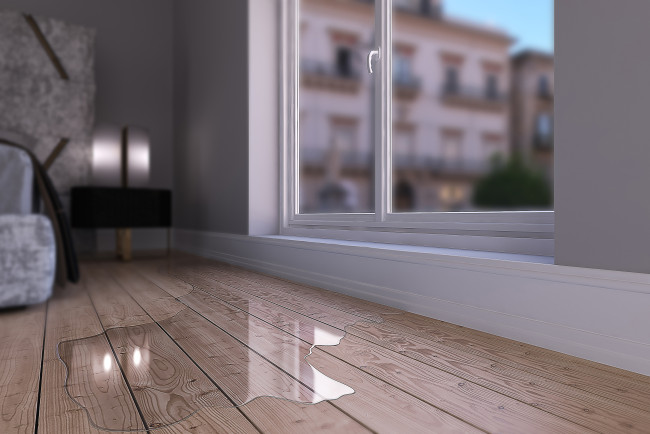Why you should consider a building's climate disaster risk when buying in NYC
- Check if your building is in a FEMA flood zone, on a city rainfall flood map, or on top of an underground river
- Use the Department of Buildings’ websites to check if your facade is air-tight and read up on past complaints

Like location and views, how a building will fare during an intense storm should be a top consideration.
iStock
Ten years ago, Hurricane Sandy hit New York City’s shores, causing $19 billion in damages and killing 44 residents. Three months ago, Gotham’s skies turned orange as smoke from Canadian wildfires coated the skies. The impact of climate change is all around us, and it's pushed New Yorkers to relocate or buy property outside the city.
But what about the folks who still want to buy in NYC?
“[Climate change] doesn’t come up as often as it should,” says Ellen Sykes, a licensed associate real estate broker at Coldwell Banker Warburg. “I’m always surprised. I either think [the client] is smart, they know what they’re doing, or they haven’t a clue.”
To Sykes, who remembers the damage Hurricane Sandy wrought on the city, extreme weather caused by climate change should be something home-buyers consider before putting down roots. But it can be easy to ignore.
“I think we all have to make a living…and we also are all very scared about climate change,” Sykes says. “Every year the summers get worse and we all say, ‘oh, it's not gonna get better than this.’ But I think subliminally, we're all hoping it will. Maybe there's a certain amount of denial going on about what's really happening.”
Home buyers, however, should think about climate change impact when it comes to where they invest, says Mona Hemmati, a postdoctoral research scientist at the Lamont-Doherty Earth Observatory of Columbia University. New Yorkers are seeing the impacts of climate change today, and it’s something Hemmati herself is taking into account in her search for a new home.
“Climate change is creating some ongoing challenges and we need to think about it more seriously.” Hemmati says. “It is not a far, distant type of threat. This is something that is already happening.”
There are a handful of things a potential home buyer can look for in NYC’s crop of condos, co-ops, and brownstones that would make a building more resistant to the weather events—like floods and wildfires—including the building’s location on or off of a floodplain, where its mechanicals are stored, any special certifications, and its ventilation system.
Read on for a list of three things to consider before buying a home if you’re concerned about climate change.
[Editor’s note: This story is part of a new, ongoing series about how you can take into account climate change when purchasing a home. If climate change was a part of your home-buying process, send us an email here. We may contact you for future stories. ]
Is this building prepared for flood?
Floods can have a huge impact on property, even for those who live on higher floors. If a building stores their heat, electricity, or elevator mechanicals in the basement, a flood can knock out those systems, resulting in expensive repairs and interrupted service. And floods are likely to increase as sea levels rise and storms become more frequent.
If you’re a prospective home-buyer, you should check to see if your building is at risk for flood. You can find out if your building is on an underground river using maps from the 1860s here. You can also search the Federal Emergency Management Agency’s (FEMA) flood maps online, but remember that FEMA’s flood maps only show past flooding, and cannot predict that a building will be safe from worsening floods in the future.
FEMA’s maps identify two types of flood hazards: a special flood hazard area, also known as a region that has a 1 percent chance of a once-in-100-year flood in any particular year, and a moderate flood hazard area, which has a 0.2 percent chance of experiencing a once-in-500-year flood in any single year.
But when Hurricane Ida damaged 33,500 buildings in 2021, only 6.9 percent of those properties were on the 100-year floodplain and about 13.7 percent were on the 500-year floodplain, according to the city. Sustained rainfall was partially to blame, overwhelming the city’s sewer system and resulting in subway, cellar, and basement flooding outside FEMA’s flood zones.
However, NYC created three rainfall-based flooding maps you can use to check your potential home’s risk for flood from sea level rise and stormwater. You can also check your flood risk through the nonprofit the Center for New York City Neighborhoods’ online tool, FloodHelpNY.
The website uses FEMA’s flood maps plus preliminary versions of updated maps FEMA will roll out with its new rating system for the National Flood Insurance Program (NFIP), dubbed Risk Rating 2.0, says Christopher Zimmerman, a senior program manager with the nonprofit. But flood maps aren’t perfect, Zimmerman says.
“I always really encourage folks to look at flood zones when assessing the risk of a place they are moving into, [but] it’s not a perfect science. As we found with Ida and other storms, there’s a lot of inland flooding happening now too in episodes of sewer backflow from city sewer systems,” Zimmerman says. “Just because we're not located in a flood zone does not preclude the possibility of flood events.”
You should also ask to see where your building’s mechanicals are stored. If they’re in the basement, they could be at risk of damage during floods. Storing them on higher floors will help mitigate damage, but won’t rule out flood damage to basements that have other uses, like laundry, gyms, or storage.
“There’s no perfect protection against floods,” Zimmerman says. “With lofted mechanicals, you will likely be able to maintain your heating or cooling during a storm event instead of being completely inundated with floodwaters, but it’s not a silver bullet. It will only mitigate storm damage.”
Does your building have a special certification?
When you think of green buildings, most people think of Leadership in Energy and Environmental Design, also known as LEED. The designation refers to the energy efficiency of a building, and is administered by the U.S. Green Building Council to encourage architects to design environmentally-friendly buildings.
LEED is aimed more at limiting a building’s carbon emissions, and for good reason. Heating, cooling and lighting NYC’s buildings generate roughly 70 percent of the city’s carbon emissions, according to the New York Times. But LEED also offers some protections against the consequences of climate change, says Jennifer Owens, the quality director of LEED residential at the Green Building Council.
For example, developers are instructed not to build on FEMA’s flood hazard zones, or if they do, have to enact flood management strategies and at minimum, must adhere to FEMA’s NFIP floodplain management requirements, according to LEED’s rating system for residential buildings.
“All the residential certified buildings would have had to meet the prerequisite called floodplain avoidance,” Owens says. “And the floodplain avoidance prerequisite requires that the building is not developed on land that lies within the hazard area as designated by FEMA’s 100-year flood plain maps, or as otherwise legally designated or by local jurisdictions or or state.”
LEED also requires ducted residential buildings to have indoor air filters with a minimum efficiency reporting value (MERV) of eight or higher, meaning the filter is able to trap small particles within a building. Indoor air filtration can be crucial for mitigating the effects of poor air quality—like NYC saw during the Canadian wildfires.
Plus, LEED requirements are designed to make a building more efficient at trapping heat in winter months and keeping it out in summer months, which will be helpful as temperatures rise, Owens says.
Passive House buildings offer similar benefits. The set of design standards that make up Passive House help a building be more energy efficient, but they also provide a steady flow of filtered air within a tightly sealed building, limiting the amount of heating and cooling required and keeping outside air from leaking in.
But Prabhu Perumalsamy, a principal at the engineering and architectural design firm O&S Associates, cautioned against accepting new, certified buildings as inherently safer. Anything is capable of failure, he says.
“Even the newest building with all the greatest technology may operate perfectly today, but in five years, you don't know how that's going to go,” Perumalsamy says.
Andrew Wilson, a regional director for O&S, recommends looking at a new building’s expected maintenance costs in the developer’s offering plan, which informs residents about what they’re expected to contribute towards repairs and maintenance. For existing buildings, he recommends looking at a condo or co-ops capital reserve study, if you can get it.
A capital reserve study informs existing residents about the upgrades and repairs necessary to keep a building operational, and will let you see what the existing condo or co-op board thinks are potential threats to their property. But boards are more likely to keep the study as an internal document, not disclosed to buyers, to protect it from legal liability.
For LEED-certified buildings, Owens recommends looking at a property’s durability management checklist, which outlines what the architect and engineers have instituted to protect the building and its systems. If you read that checklist and see that they did not consider a factor like flood, you should investigate why it wasn’t taken into account.
“I live in California. If I was to look at my durability management plan and I didn't see fire and earthquake, I would know that there was potentially a gap and I would want to go further,” Owens says. “If I did see those things on my durability management plan, then I'd know that the builder was thinking about those things.”
How does your building handle airflow, heat, and insulation?
Unless the sky turns orange, it can be difficult to tell when NYC’s air quality declines. Similarly, it’s tricky to tell whether a building is well-ventilated and insulated unless you’re an expert. But outside of hiring an engineer, there are a few ways to check out a potential condo or co-op property’s mechanical systems.
First off, touring the building can give you some crucial insights on its design. Let’s start at the top: the roof. Does the building have a green roof, helping to absorb rainwater and prevent excess heat, or is it painted white, which reflects and reduces heat from the sun? White roofs can help keep a building cool in the increasingly hot summer months, Perumalsamy says.
You can also ask your agent about how the building is insulated. For example, are your windows double-glazed or covered with a low emissivity coating, which reduces heat from the sun entering the building and prevents heat loss from the windows? Can you open and close the windows, and when you shut them, is there a tight seal?
Your agent should be able to answer these questions, and a new development should include information about the building’s construction in its offering plan, Perumalsamy says. You should also make sure to tour a building’s heating, ventilation, and air conditioning (HVAC) system to see what floor it’s located on—think flood—and whether it looks well maintained.
While it can be difficult for a layperson to identify problems, seeing the HVAC system can be a good gut check, Wilson says
“Almost all of the buildings in NYC are designed to have fresh air brought into it from the outside and they have a minimum amount that is required to be brought into these buildings,” Wilson says. “That fresh air is filtered. We have filters that are in those HVAC systems. How good that performs is almost all a function of how well those systems are maintained by building management. Looking at their HVAC rooms, looking at some of their mechanical rooms, you get a sense of if this building is well maintained, is this equipment well taken care of.”
You can also head to the Department of Buildings (DOB) to examine a host of issues, such as a building’s permits, past complaints, safety hazards and more through DOBNow and DOB’s Building Information Search.
Perumalsamy recommends checking a building’s exterior wall and facade inspection—which properties of more than six stories are required to do every five years—to see if the architect mentioned the building’s sealants or weather tightness as a problem.
But what Perumalsamy emphasized most was flood. Even his Hell’s Kitchen home flooded during Hurricane Ida, despite having never flooded before.
“We are uphill but enough water came in that it flooded the lobby, gym and the basement,” Perumalsamy says. “We obviously can't change the street, we can't change the slope. So we did invest in simple things like sandbags and collapsible barriers…Whenever there’s a hurricane warning we seal all the doors—not permanently obviously—to prevent flooding.”
Almost everyone interviewed for this article had a flood story. Climate change—while maybe not at top of mind for all of NYC’s homebuyers, per Sykes—is certainly already having an impact.
You Might Also Like































